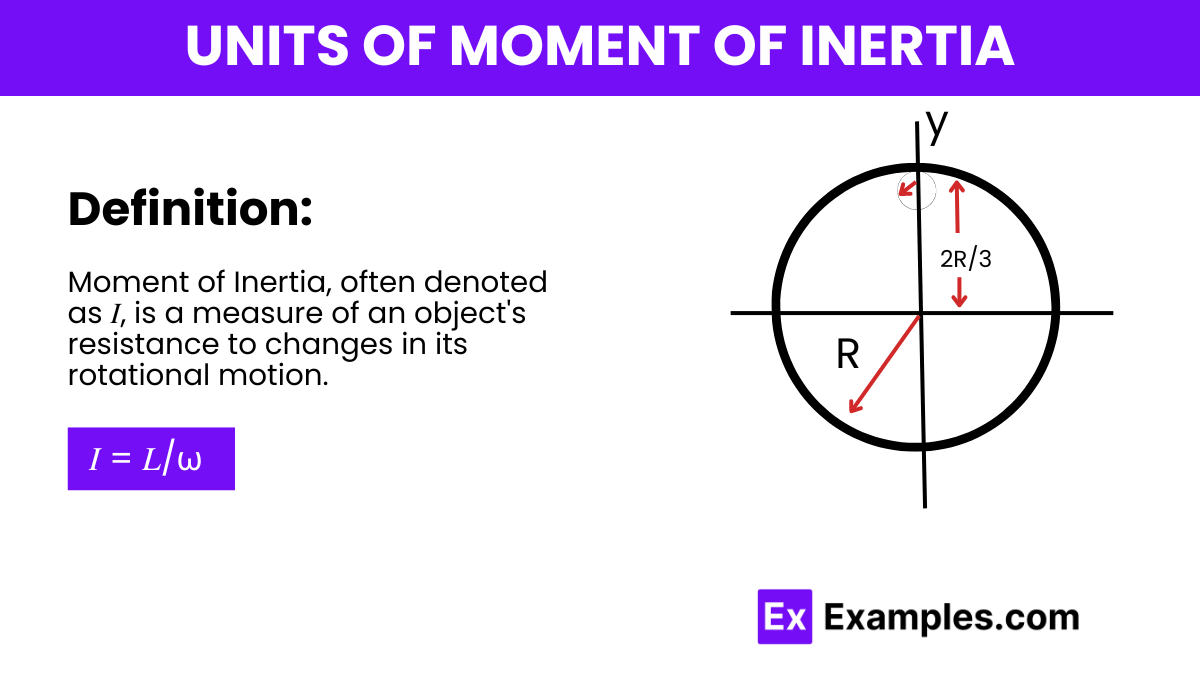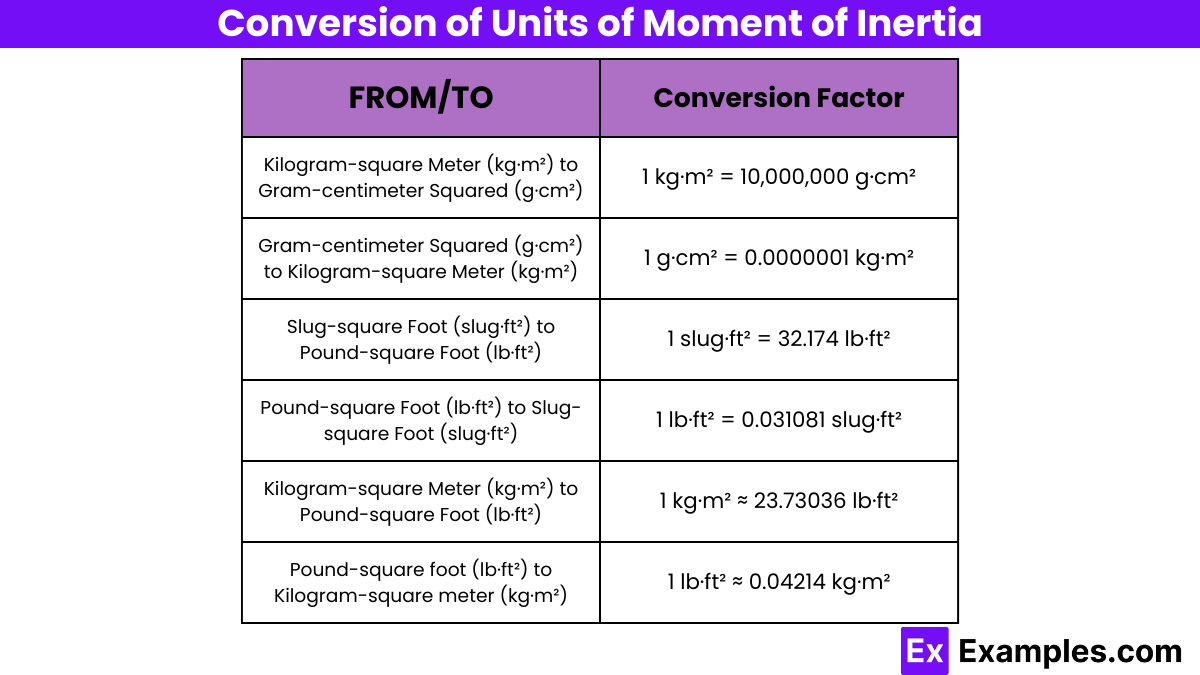What is the SI unit of moment of inertia?
kg·m²
kg·m/s²
N·m
J

The formula represents the moment of inertia (𝐼) of an object rotating about an axis, where 𝐿 is the angular momentum and 𝜔 is the angular velocity. This formula relates the rotational inertia of an object to its angular momentum and angular velocity, providing insight into the object’s resistance to changes in its rotational motion.
The units of moment of inertia depend on the specific formula used to calculate it and the units of its components. In general, the moment of inertia is expressed in units of kilogram meters squared (kg·m²) or gram centimeters squared (g·cm²). These units arise from the combination of mass units (kilograms or grams) and distance units (meters or centimeters) squared. The moment of inertia quantifies the rotational inertia of an object and represents a measure of its resistance to changes in its rotational motion. It is a fundamental concept in physics and engineering, essential for understanding the behavior of rotating objects and designing mechanical systems.
The SI (International System of Units) unit of moment of inertia is kilogram meter squared (kg·m²). This unit combines the SI units for mass (kilogram) and distance (meter) squared, reflecting the rotational inertia of an object relative to its axis of rotation.
The CGS (Centimeter-Gram-Second) unit of moment of inertia is gram centimeter squared (g·cm²). This unit combines the CGS units for mass (gram) and distance (centimeter) squared, providing a measure of rotational inertia relative to the axis of rotation in CGS-based calculations and analyses.
1.Solid Cylinder (Axis along the center): The moment of inertia for a solid cylinder about its central axis is given by the formula I = 1/2 𝑀𝑅² , where 𝑀 is the mass and 𝑅 is the radius of the cylinder.
2.Hollow Cylinder (Axis along the center): For a hollow cylinder (like a pipe), the moment of inertia is 𝐼 = 𝑀𝑅² , assuming the mass is concentrated at the radius 𝑅 from the central axis.
3.Solid Sphere (Axis through the center): The moment of inertia for a solid sphere about any axis through its center is 𝐼 = 2/5 𝑀𝑅²
4.Hollow Sphere (Axis through the center): For a hollow sphere, the moment of inertia is 𝐼=2/3 𝑀𝑅²
5.Thin Rod (Axis through one end, perpendicular to length): If the axis is through one end of the rod, perpendicular to its length, the moment of inertia is 𝐼=1/3 𝑀𝐿²
| Unit System | Unit | Symbol | Description |
|---|---|---|---|
| SI | Kilogram-square meter | kg·m² | The SI unit of moment of inertia. |
| CGS | Gram-centimeter squared | g·cm² | The CGS unit of moment of inertia. |
| Imperial | Slug-square foot | slug·ft² | Used in the imperial system, less common in engineering. |
| Engineering | Pound-square foot | lb·ft² | Commonly used in the United States for engineering. |
This is the standard SI unit for moment of inertia, where the mass is in kilograms and the distance squared is in meters. It is predominantly used in scientific and engineering applications worldwide due to its straightforward relation to other SI units.
Used in the CGS system, this unit measures moment of inertia where mass is in grams and distance squared is in centimeters. It is less commonly used today but still appears in some academic contexts and older literature.
In the imperial system, particularly used in the United States, the slug-square foot is occasionally used in engineering contexts. The slug is the unit of mass, and feet are the units of distance.
Also from the imperial system, this unit is more commonly encountered in engineering practices within the United States. It is particularly used in situations where the pound and foot are the standard units for mass and distance, respectively.

| From Unit | To Unit | Conversion Factor |
|---|---|---|
| Kilogram-square meter (kg·m²) | Gram-centimeter squared (g·cm²) | 1 kg·m² = 10,000,000 g·cm² |
| Gram-centimeter squared (g·cm²) | Kilogram-square meter (kg·m²) | 1 g·cm² = 0.0000001 kg·m² |
| Slug-square foot (slug·ft²) | Pound-square foot (lb·ft²) | 1 slug·ft² = 32.174 lb·ft² |
| Pound-square foot (lb·ft²) | Slug-square foot (slug·ft²) | 1 lb·ft² = 0.031081 slug·ft² |
| Kilogram-square meter (kg·m²) | Pound-square foot (lb·ft²) | 1 kg·m² ≈ 23.73036 lb·ft² |
| Pound-square foot (lb·ft²) | Kilogram-square meter (kg·m²) | 1 lb·ft² ≈ 0.04214 kg·m² |
This conversion is based on converting kilograms to grams (1 kg = 1000 g) and meters to centimeters (1 m = 100 cm), then squaring the distance conversion.
This conversion inversely scales down the mass from grams to kilograms and the squared distance from centimeters to meters.
Since one slug is equal to 32.174 pounds (the gravitational constant in ft/s²), this conversion accounts for the difference in mass units while keeping the distance in feet.
This conversion utilizes the reciprocal value of the gravitational constant to convert pound-mass units back to slugs, maintaining the square of feet for the moment of inertia.
This conversion combines the mass conversion from kilograms to pounds (1 kg = 2.20462 lbs) and the distance conversion from meters to feet (1 m = 3.28084 ft), then squares the distance.
This conversion combines the mass conversion from Pound-square foot to Kilogram-square root (1 lb·ft² ≈ 0.04214 kg·m²).
The units of section moment of inertia are typically expressed as length to the fourth power, such as
𝑐𝑚4 or 𝑖𝑛4 in engineering contexts.
The unit of the first area moment of inertia is typically length cubed, such as 𝑐𝑚3, reflecting the product of area and distance.
Text prompt
Add Tone
10 Examples of Public speaking
20 Examples of Gas lighting
What is the SI unit of moment of inertia?
kg·m²
kg·m/s²
N·m
J
Which of the following represents the moment of inertia for a solid sphere of mass M and radius R?
1/2MR²
2/5MR²
3/4MR²
MR²
Which unit is used to measure the rotational analog of mass?
kg·m²
kg·m/s
N·m²
J·s
The moment of inertia of a point mass m at a distance r from the axis of rotation is:
mr
m²r
mr²
m²r²
Which of the following objects has the greatest moment of inertia, assuming equal mass and radius?
Solid sphere
Hollow sphere
Solid cylinder
Thin hoop
What is the unit of moment of inertia in the CGS (centimeter-gram-second) system?
g·cm²
g·cm/s²
dyn·cm
erg
Which physical quantity does the moment of inertia influence in rotational motion?
Linear velocity
Angular velocity
Angular acceleration
Linear acceleration
If the radius of a rotating object is doubled, how does its moment of inertia change, assuming mass remains constant?
It is halved
It remains the same
It is doubled
It is quadrupled
Which unit is used to measure the rotational inertia of a flywheel?
kg·m
kg·m²
N·m²
J
What is the effect on the moment of inertia if the mass of an object is doubled while its radius remains constant?
It is halved
It remains the same
It is doubled
It is quadrupled
Before you leave, take our quick quiz to enhance your learning!

